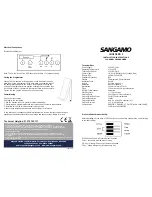
ECO GOLD
106
Appendix with settings
25/08/2011/
YACE0088
Alternatives for Windows Vista and Windows 7:
−
Download various freeware programs from the Internet.
−
Copy program "Hyper Terminal" from an old operating system.
To do this copy hypertrm.exe from C:\Programs\Windows NT and both of the DLL files hypertrm.dll and
hticons.dll from C:\WINDOWS\system32. All this can be packed into any directory and used as a port-able
application. Now access can be obtained to the RS 232 interface.
G.3.2 RS 232 protocol
Note the following aspects:
−
The interface operates with one stop bit, no parity bit and with eight data bits.
−
Transfer speed alternatively: 2400, 4800, 9600 (factor setting) or 19200 baud.
−
The RS 232 interface can be operated with or without hardware-handshake (RTS/CTS).
−
The command from the computer must be terminated with a CR, CRLF or LFCR.
−
The response from the thermostat is always terminated with a CRLF.
CR = Carriage Return (Hex: 0D); LF = Line Feed (Hex: 0A)
Example:
Set-value transfer of 30.5 °C to the thermostat
Computer
Thermostat
„OUT_SP_00_30.5“CRLF
Ö
Õ
„OK“CRLF
G.3.3 RS 485 connecting lead
Thermostat
9-pole Sub-D socket
Contact
Data
1
Data A (-)
5
SG (Signal Ground)
optional
6
Data B (+)
−
Use screened connecting leads. Connect screen to the plug housing.
−
The wires are electrically isolated from the rest of the electronics.
−
Non-assigned pins should not be connected.
An
RS 485 bus
requires essentially a bus termination in the form of a terminating network, which pro-
vides a defined idle state in the high impedance phases of bus operation. The bus termination is as fol-
lows:
Generally, this terminating network is integrated on the PC plug-in card (RS 485).














































